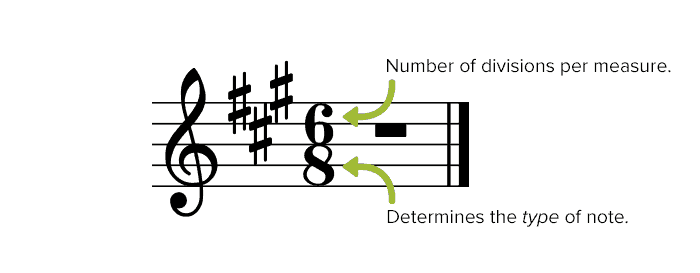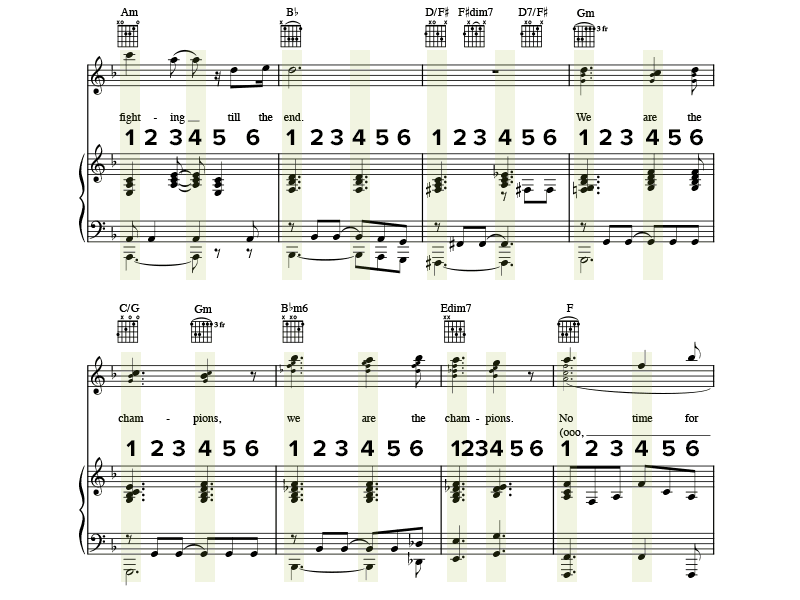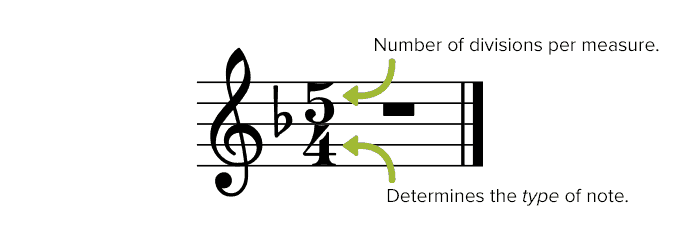A Complete Guide to Time Signatures in Music
Have you ever found yourself tapping your foot along to a great song? Well, every time you’re tapping your foot or clapping your hands, you’re actually emphasizing the beat in the song!

Have you ever found yourself tapping your foot along to a great song? Well, every time you’re tapping your foot or clapping your hands, you’re actually emphasizing the beat in the song. Time signatures in sheet music are used to specify how many beats are contained in each measure of music, and which note value is equivalent to one beat.

In sheet music, vertical black bars called bar lines divide the staff into measures.
The time signature in music is represented by a set of numbers, one on top of the other, resembling a fraction. In sheet music, the time signature appears at the beginning of a piece as a symbol or stacked numerals immediately following the key signature (or immediately following the clef symbol if the key signature is empty).
There are three main types of time signatures: simple, compound, and complex. We’re going to dive into each type and what their numbers mean, so the next time you’re checking out at a piece of sheet music, you’ll know exactly what you’re looking at!
Simple Time Signatures
Time signatures where the beat can be divided into two equal parts are known as simple time signatures. Simple time signatures are the most common kind of time signature and they pop up regularly in popular music due to the clear, easy to determine beats. The most common simple time signatures you will see are 2/4, 3/4, and 4/4, although any time signature with a 2, 3, or 4 as the top number is classified as simple.
In order to truly understand simple time signatures, you must understand what the numbers represent. The top number determines how many beats are in a measure, while the bottom number determines what type of note gets the beat.

Looking at the example above, we can see that the top number is “4,” telling us that there are four beats in one measure. But what kind of note gets the beat? The bottom number of a time signature can be 1, 2, 4, 8, 16, and so on. These numbers coordinate with the following types of notes:
-
- 1: Whole Note (very rare)
- 2: Half Note
- 4: Quarter Note
- 8: Eighth Note
- 16: Sixteenth Note
- You could continue to 32, 64, and so on, but hopefully, you’ll never encounter such a time signature!
Now that we can see the bottom “4” in this time signature represents a quarter note, we can conclude that a 4/4 time signature means there are a total of four beats per measure, and one quarter note equals one beat.
It’s important to know this doesn’t mean there can only be four quarter notes in each measure, but rather that the total note value of each measure will add up to four quarter notes. For example, you could see any of the rhythms below, because they all consist of four quarter note beats in total.

As we said before, a simple time signature indicates that the beat can be divided by two. Let’s look at this example of a 3/4 time signature.

We know that a 3/4 time signature means there are three beats in a measure, and one quarter note equals one beat. Notice in the second measure that each of those beats can be divided in two.
Compound Time Signatures
Compound time signatures differ from simple time signatures in that the beat is divided into three equal parts, rather than two. The top number of compound time signatures is commonly 6, 9, or 12 (multiples of 3), and the most common time signatures you will see are 6/8, 9/8, and 12/8. The numbers in these time signatures function nearly the same as simple time signatures, but there is one key difference.
The bottom number means the same thing as it does in simple time signatures. The difference is with the top number.
While the top number in simple time signatures represents how many beats are in a measure, the top number in compound time signatures represents the number of divisions in a measure. While “divisions” and “beats” may seem like the same thing, we’re going to demonstrate why they are different.

The time signature above tells us that there are six notes (or divisions) per measure, and an eighth note is equal to one division. However, 6/8 is felt in two, meaning that songs in 6/8 seem as though there are only two beats per measure instead of six.
Feel it out yourself by listening to “We Are The Champions” by Queen and tapping out the beat.
Though you could tap “1, 2, 3, 4, 5, 6” over and over again, you’ll naturally find yourself tapping “1, 2, 1, 2, 1, 2.” This is because the beat emphasis is on the 1st and 4th eighth notes in each measure. You can even see this reflected in the sheet music.

Now that we understand that 6/8 is felt in two, we can observe that there are two beats per measure, with the dotted quarter note getting the beat. This is where the division of the beat into three equal parts comes in. Each dotted quarter note can be divided into three eighth notes, and since there are two dotted quarter notes per measure, there are six eighth notes, hence the 6/8 time signature.

Just like we talked about in simple time, each measure doesn’t have to have six eighth notes, but rather the equivalent beat value.

Complex Time Signatures
An odd meter is a meter that contains both simple and compound beats. These meters aren’t nearly as common, but they’re important to be able to recognize in a piece of sheet music. We call time signatures that contain odd meters complex time signatures.
An example of a complex time signature is 5/4. Since finding the “beat” in complex time signatures can be tough, we will approach it the same way we approach compound time signatures.

Dissecting 5/4 time, we can determine that there are five notes (or divisions) per measure, and a quarter note is equal to one division. The grouping of these quarter notes can either be in 3+2 or 2+3, but either way, you’ll see the combination of a simple beat (division of 2) and a compound beat (division of 3).

To listen to a few songs in 5/4, check out the Mission Impossible Theme, or “Take Five” by Dave Brubeck.
Application
Now that we’ve covered all of the types of time signatures, let’s apply what we know and classify a new time signature! Let’s use 9/8, the time signature found in Debussy’s famous “Clair de Lune.“

Step 1: Is the top number a 2, 3, or 4?
Recall that simple time signatures will always have a 2, 3, or 4 as the top number. Look for this first! If you have one of these numbers, you can rest easy knowing you’re in a simple time signature. Since we have a “9” here, we’ll go to step two.
Step 2: Analyze the numbers and write out one full measure.
Now that we know we’re dealing with either a compound or complex time signature, we know that the top “9” refers to the number of divisions in each bar. For the bottom number, recall that the “8” stands for an eighth note, so we can now conclude that 9/8 means there are nine eighth notes in each measure.

Step 3: Do the notes divide into equal groups?
As you can see in the image above, the notes fall into equal groups of three, meaning we have a compound time signature! If this hadn’t been the case, you would then know you were dealing with a complex time signature.
Now it’s your turn! The next time you come across a new time signature, you can use this same application to determine whether you are in simple, compound, or complex meter. The more you do this, the more comfortable you will become with time signatures, and soon enough, you’ll be a time signature genius!
Author: Musicnotes
Date first published: 2019/03/12

